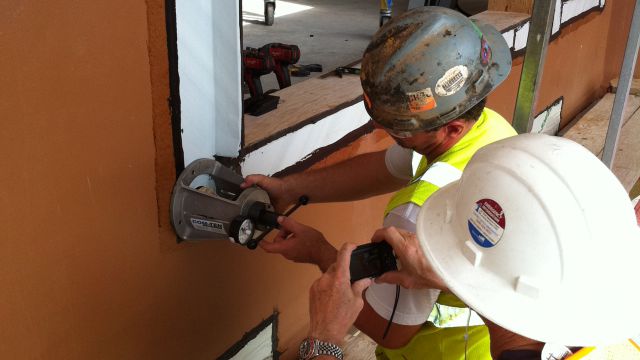Detailing air barriers
Air barriers and insulation
By Russell Snow
High-performance buildings are constructed to maximize energy efficiency, durability and overall occupant comfort. As the demand for these buildings continues to increase, it is important to understand that one of the key aspects of achieving this is proper building enclosure design and overall wall system performance.
Through the use of control layers within the wall assembly and proper placement and installation, the building can be protected from unwanted air and moisture infiltration. Ultimately, this contributes to an energy efficient and durable building. These control layers are comprised of a water control layer, air control layer, thermal control layer, and vapor control layer. Each of these plays an important role in a building’s performance.
It is important to understand that the building enclosure needs to be designed in such a way as to provide environmental separation. In other words, provide separation of the inside from the outside. As part of the enclosure, the control layers can either be a single product or a combination of materials, and their importance has been recognized for years. Consequently, industry design professionals have incorporated these as standard elements into the building enclosure system.
The water control layer is a critical part of the building enclosure and is designed to reduce the wetting potential due to moisture intrusion. A wall is going to get wet; this is inevitable. It needs to be designed so that it has the ability to dry. This consists of strategies to allow for deflection of the water away from the structure, drainage of water that enters the structure, and the use of materials to provide waterproofing protection.
The air control layer is just as important as the water control layer. It has been recognized as such over the years. Air leakage can be defined as the flow of air through gaps and cracks in the building enclosure and can be from the outside in, or from the inside out, as a result of different air pressures, such as wind, stack and mechanical pressures. The air control layer is designed to address this uncontrolled air movement, whether it is the unconditioned exterior air, or the conditioned interior air.
Additionally, control of air flow can help restrict heat flow and, ultimately, dew point temperatures. Control of dew point also is essential, as even a properly designed wall can have unconditioned air (cold) cause condensation by changing designed dew point temperatures by reducing the surface temperatures of materials within the assembly.
Taking a cold climate as an example, uncontrolled air leakage may lead to a significant amount of heat loss as warm air is displaced by the colder air from outside. Also, air leakage of warm, moist air from the interior to the exterior can lead to condensation within the envelope (interstitial condensation). In fact, air leakage can contribute a significant amount of moisture within a wall if not controlled.
Incorporation of an air barrier within the building enclosure is essential for a building to be considered energy efficient. A complete air barrier system can contribute to overall energy efficiency of a structure. There have been numerous studies investigating this, including one by the National Institute of Standards and Technology (NIST). It showed that inclusion of an air barrier system in non-residential buildings can reduce air leakage by up to 83 percent; provide potential gas savings of greater than 40 percent; and result in electrical savings of greater than 25 percent. An incomplete air barrier system allows for unconditioned air leakage into a structure (infiltration) and conditioned air leakage out of the structure (exfiltration). This causes increased heating and cooling costs as well as the uncontrolled movement of moisture through the building enclosure.
The vapor control layer reduces the movement of water vapor as a result of differences in relative humidity and temperature. This may or may not be required, based on climate and wall design. If it is included, proper placement of this layer is important to avoid moisture problems.
The thermal control layer resists thermal transfer through the building enclosure. The use of this layer not only provides occupant comfort, but allows for control of a dew point within the enclosure by maintaining temperatures above the dew point temperature. Care should be taken in placement of insulation, so as to avoid thermal bridging. With the changes in building codes across the country, the use of continuous exterior insulation now is being incorporated to address this.
Control of air leakage and moisture movement can be accomplished within a building enclosure by the incorporation of a continuous air barrier system, thermal control, a vapor retarder and a drainage plane. Each of these elements are essential for a wall to “work.” The placement within the wall assembly is critical to provide the energy efficiency, durability and occupant comfort that is expected of a high-performance building.
About the Author
Russell Snow, LEED AP, Building Science Specialist for W. R. MEADOWS. Snow develops specs and provides technical support on building enclosure and related products. He has 20 years of experience in the construction industry. He completed his Building Science Program at the University of Toronto and has most recently attained the Building Science Specialist of Ontario designation. Snow’s experience includes building envelope, concrete restoration and products used in the treatment of concrete.
Snow is vice-chair of the Air Barrier Association of America, and a member of the ASTM E06, ASTM D08 and American Concrete Institute committees. He has also been involved with Construction Specifications Canada and is involved nationally with the CSC Educational Maintenance Task Team, including being the Chair of the Technical Representative Course Committee.



















